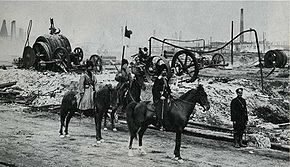Armenian–Tatar massacres of 1905–1907
| Armeno-Tartar War | |||||||
|---|---|---|---|---|---|---|---|
 A Cossack military patrol near the Baku oilfields, ca. 1905. | |||||||
| |||||||
The Armenian-Tatar massacres (also known as the Armenian-Tartar war and the Armeno-Tartar war) refers to the bloody inter-ethnic confrontation between Christian Armenians and Muslim Caucasian Tartars throughout the Caucasus in 1905—1907.[1][2][3]
The massacres started during the Russian Revolution of 1905, and claimed hundreds of lives. The most violent clashes occurred in 1905 in February in Baku, in May in Nakhichevan, in August in Shusha and in November in Ganja, heavily damaging the cities and the Baku oilfields. Some violence, although of lesser scale, broke out also in Tbilisi. According to professor Firuz Kazemzadeh, "it is impossible to pin the blame for the massacres on either side. It seems that in some cases (Baku, Elizavetpol) the Azerbaijanis fired the first shots, in other cases (Shusha, Tiflis) the Armenians".[4] Kazemsadeh believes that Dashnaktsutiun as a party bears a major portion of responsibility, for it was often the leading force in perpetrating the massacres. The Dashnaks organized bands, which consisted mostly from refugees from Turkey, and would often exterminate the populations of entire Muslim villages, while the Azerbaijanis had no organization, comparable to the Dashnaktsutiun, and fought without coordination or plan.[4] The clashes were not confined to the towns, and, according to an Armenian estimate, 128 Armenian and 158 Muslim villages were destroyed or pillaged, while the overall estimates of lives lost vary widely, ranging from 3,000 to 10,000, with Muslims suffering higher losses.[5]
In Nakhichevan
After the Baku clashes, the Moslem communities in the Nakhichevan district began smuggling in consignments of weapons from Persia. By April the murder of Armenians there began to assume alarming proportions and they applied to the Russian authorities for protection. However, Villari describes the district's governor as "bitterly anti-Armenian", and the vice-governor in Yerevan as an "Armenophobe". [6]
On the 25th May, acting on a prearranged plan, bands of armed Tartars attacked the market area in the district capital, the town of Nakhichevan, looting and burning Armenian businesses and killing any Armenians they could find. About 50 Armenians were murdered and some of the shopkeepers were burnt alive in their shops. On the same day, Tartar villagers from the countryside began attacking their Armenian neighbours. Villari cites official reports mentioning that out of a total of 52 villages with Armenian or mixed Armenian-Tartar populations, 47 were attacked, and of that 47, 19 were completely destroyed and abandoned by their inhabitants. The total number of dead, including those in Nachichevan town, was 239. Later, in a revenge attack, Armenians attacked a Tartar village, killing 36 people.
-
The village of Djagry in Nakhichevan district: "the house of a rich Armenian burnt by Tartars".[7]
-
An Armenian church in Gyaz village in Nakhichevan district "plundered and desecrated by Tartars".[8]
-
A monument in Berdadzor, Nagorno-Karabakh Republic, to Armenian victims of the 1905-1906 Armenian-Tatar Massacres.
References
- ^ Britannica Online Encyclopedia. Azerbaijan. History.
- ^ Brockhaus and Efron Encyclopedic Dictionary. Turks
- ^ Willem van Schendel, Erik Jan Zürcher. Identity Politics in Central Asia and the Muslim World: Nationalism, Ethnicity and Labour in the Twentieth Century. I.B.Tauris, 2001. ISBN 1860642616, 9781860642616, p. 43
- ^ a b Firuz Kazemzadeh. Struggle For Transcaucasia (1917—1921), New York Philosophical Library, 1951
- ^ Tadeusz Swietochowski. Russia and Azerbaijan: A Borderland in Transition. Columbia University Press, 1995. ISBN 0231070683, 9780231070683
- ^ Villari, Luigi. Fire and Sword in the Caucasus. London: T. F. Unwin, 1906 ISBN 0-7007-1624-6 p. 270.
- ^ Villari, Luigi. Fire and Sword in the Caucasus. London: T. F. Unwin, 1906 ISBN 0-7007-1624-6 p. 285
- ^ Villari. Fire and Sword, p. 290
Bibliography
- Luigi Villari (1906), Fire and Sword in the Caucasus [1], London, T. F. Unwin, ISBN 0-7007-1624-6
- Thomas De Waal (2004), Black Garden: Armenia and Azerbaijan Through Peace and War, NYU Press, ISBN 978-0-8147-1945-9
External links

![The village of Djagry in Nakhichevan district: "the house of a rich Armenian burnt by Tartars".[7]](http://upload.wikimedia.org/wikipedia/en/thumb/8/8b/Tatarmas.jpg/120px-Tatarmas.jpg)
![An Armenian church in Gyaz village in Nakhichevan district "plundered and desecrated by Tartars".[8]](http://upload.wikimedia.org/wikipedia/commons/thumb/2/2f/Churchplunderda.jpg/86px-Churchplunderda.jpg)
